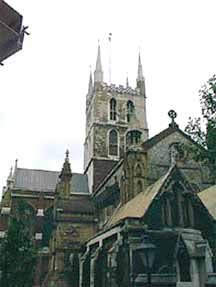|
|

St. Saviour's, Southwark
Borough High Street, Southwark, SE1
 How many hundreds of people pass this beautiful church each day without even realising it's there, much less what lies inside? How many hundreds of people pass this beautiful church each day without even realising it's there, much less what lies inside?
Placed as it is at one of the busiest junctions in London and given that all that can be seen from the road is the upper portion and spire, perhaps it is not so surprising that the ancient St. Saviour's, Southwark, is so often missed. But it is a pity because as well as possessing a marvellous atmosphere of serenity and calm, the Cathedral building houses the most interesting collection of tombs and epitaphs outside of Westminster Abbey.
Southwark Cathedral is by no means a dusky repository for the dead, though. Throughout it's long history it has played a vital role in the life of London's South Bank and it has a surprisingly rich heritage as a result.
Unlikely as it might seem today, Southwark Cathedral stood at the heart of one of the liveliest and most notorious districts of the city. When the Roman Army made camp on the Bankside innumerable brothels opened to cater for the needs of its soldiers. Some centuries later, when the area came under the control of the church, the whore houses were still flourishing. Business continued as normal and the profits became a substantial source of revenue for the Bishops of Winchester, whose lands included this part of London.
Although Henry VIII finally shut down the Bishop's brothels, others took their place and Southwark's reputation as a pleasure garden went on undiminished. Of course, sexual incontinence was not the only form of entertainment to be found on the Bankside. Theatres, bear-baiting rings and cockpits were amongst the amusements and hundreds of taverns also plied a fine trade.
A sort of Soho and West End combined, Southwark positively seethed with activity. This was the Southwark to which Shakespeare came with the Globe Theatre and he probably lived close by, in the shadow of the cathedral.
St. Saviour's was undoubtedly familiar to Shakespeare and he must have worshiped there many times. This much is borne out by the fact that the playwright's brother, Edmund, was buried in the church after his premature death in 1607. Since he was an actor, Edmund's passing would not normally have attracted any attention. Yet someone evidently paid to have him sent off like a gentleman.
The register states:'Edmond Shakespeare, player, buried in ye church, with a forenone knell of the great bell XXs.'
Twenty shillings was a considerable sum of money in Tudor times, nevertheless Edmund was buried in an unmarked grave. A commemorative stone was eventually placed in the paving of the choir.
William Shakespeare's connection with Southwark diminished after 1613 when he started to spend more time in Stratford. Three centuries later, a memorial to the great bard was included in the Cathedral. Reflecting the tastes of the Elizabethan era, it shows Shakespeare resting on his side, his head cupped in one hand. Behind the reclining figure is a carved frieze of the Bankside he knew, including the Globe and the Cathedral and above is a modern stained-glass window showing scenes from his plays.
While Shakespeare was still a familiar figure in the parish of St. Saviour's, another famous Englishman was just coming into the world. Born to parents who had also made the long trip from Stratford-Upon-Avon, John Harvard was baptised in the then chapel of St. John the evangelist on November 29, 1607. The entry with his father's signature is in the Cathedral registry and a copy of it is on display.
 Harvard, who as all Americans know, was responsible for the bequest which started Harvard University, was brought up in Southwark and was educated at St Saviour's Grammar School. He went on to study at Emmanuel College, Cambridge and was one of several graduates of that college who later escaped the religious intolerance of the day by emigrating to the New World. Harvard, who as all Americans know, was responsible for the bequest which started Harvard University, was brought up in Southwark and was educated at St Saviour's Grammar School. He went on to study at Emmanuel College, Cambridge and was one of several graduates of that college who later escaped the religious intolerance of the day by emigrating to the New World.
The old chapel of St. John, which has been rededicated the Harvard Chapel, dates from the 12th century although it is heavily restored. The East Window, showing St John baptising Christ flanked by two angels, was a gift from Joseph H Choate, the American ambassador in London from 1899 to 1905. It was damaged by bombing in 1948 and was restored, along with much of the fabric of the chapel, thanks to funding from Harvard alumni.
Perhaps because of these strong cultural links, Americans have chosen to commemorate two other famous citizens in Southwark Cathedral. A plaque to Oscar Hammerstein, the playwright and lyricist can be found in the Harvard Chapel and another, to the actor Sam Wanamaker (1919-1993) whose extraordinary vision and tenacity led to the reconstruction of the Globe Theatre on the Bankside, can be found beside the memorial to Shakespeare.

Southwark Cathedral is open daily from 9 am. - 6 pm.
There is no admission charge to any part of the church but donations towards its upkeep are encouraged.
 London Bridge (Northern Line) London Bridge (Northern Line)
Copyright © Jan Collie 2002
Published by permission of the author.
All rights reserved. No reproduction, copy or transmission of this publication may be made without written permission. |
|